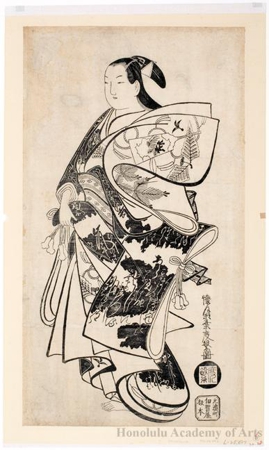
Title : Courtesan
Artist : Kaigetsudô Dohan
Date : 1710 c.
Details : More information...
Source :
Honolulu Museum of Art
Browse all 5471 prints...
Description : A young courtesan pauses in her promenade to gaze at something, her right sleeve lifted in feigned modesty. Such black and white prints (sumizuri-e) mark the beginning of ukiyo-e. James Michener, who donated this print to the Academy, stated: "A fair portion of the great Kaigetsudö prints are hand-colored, but, like most collectors, I much prefer those that are not, and this print, somewhat more fluid in design than I should have liked, demonstrates why color is not required." The motifs on her left sleeve such as a pine tree, a racket for Japanese badminton (hagoita), and a decoration for New Year's Day (two fern leaves with ribbons) suggest that this courtesan is wearing a special kimono to celebrate the New Year. Famous seasonal poems rendered in elegant calligraphy were also popular kimono designs. Kaigetsudö artists often depicted courtesans wearing yüzen-zome (a form of paste-resist dyeing). In this technique, rice paste is used to outline each shape and prevent bleeding; dyes are applied with a brush, set and then the resist is washed away. The direct application of dyes with a brush ultimately led to the development of sophisticated landscape and pictorial representations on kosode (short-sleeved kimono). (Feb 2011) ALT TEXT Kaigetsudö artists often depicted courtesans wearing yüzen-zome (a form of paste-resist dyeing). In this technique, rice paste is used to outline each shape and prevent bleeding; dyes are applied with a brush, set and then the resist is washed away. The direct application of dyes with a brush ultimately led to the development of sophisticated landscape and pictorial representations on kosode (short-sleeved kimono). A young courtesan pauses in her promenade to gaze at something, her right sleeve lifted in feigned modesty. Black and white prints (sumizuri-e) like this mark the beginning of ukiyo-e. James Michener, who donated this print to the Academy, stated: “A fair portion of the great Kaigetsudö prints are hand-colored, but like most collectors, I much prefer those that are not, and this print, somewhat more fluid in design than I should have liked, demonstrates why color is not required.” The motifs on her left sleeve such as a pine tree, a racket for Japanese badminton (hagoita), and a decoration for New Year’s day (two fern leaves with ribbons) suggest that this courtesan is wearing a special kimono to celebrate the New Year. Calligraphy of famous seasonal poems were also popular designs for kimono. Kaigetsudö artists often depicted courtesans wearing yüzen-zome (a form of paste-resist dyeing). Rice paste is used to outline each shape and prevent bleeding; dyes are applied with a brush, set and then the resist is washed away. The direct application of dyes with a brush permitted by the technique led to the development of sophisticated landscape and pictorial representations on kosode (short-sleeved kimono). (from "VOGUE in Japan: Edo Fashion through Japanese prints" exhibition 07/30/08-)
Download ImageDo you have a similar woodblock print to sell?
Get in touch with us for a preliminary estimate and for information in selling your woodblock print.
GET IN TOUCH